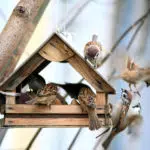Throughout National Haiku Writing Month in February, haiku fans are contemplating syllables. ‘Haiku’ refers to the unrhymed Japanese literary form made up of 17 syllables, divided into three lines of five, seven, and five syllables each. Using a limited number of words, a haiku conveys and implies much.
History of National Haiku Writing Month
The term ‘haiku’ is formed from the ‘hai’ in ‘haikai’ (a comedic style of renga, or linked-verse poetry) and the ‘ku’ in ‘hokku’ (the first renga stanza). The hokku, which established the tone for a renga, requires the description of the season, the hour of the day, and the main aspects of the landscape in its three lines, creating virtually independent poetry.
The haiku first appeared in Japanese literature in the early 1600s as a succinct response to more intricate poetry traditions, though it was not given the name “haiku” until the mid-1800s.
The hokku (also known as ‘haikai’) became recognized as the haiku in the late 1800s as it lost its primary function of starting a succession of verses. Today, the word ‘haiku’ refers to any poem with a three-line, 17-syllable pattern, including the earlier version of hokku.
Originally, the subject matter of the haiku was limited to an objective depiction of nature, reminiscent of a season, and provoking a strong, though unspoken, emotive reaction. When the haiku master, Bashō, transformed the hokku into a sophisticated and deliberate art form in the early years of the Tokugawa period from 1603 to 1867, the style gained prominence. While in Edo (modern-day Tokyo) in the 1670s, he began producing what was termed a “new type” of poetry.
Bashō went on to tour Japan, and his experiences inspired him to write poetry. His haiku appealed to a wide range of people in Japan, and its popularity helped shape the form as Japan’s most popular form of poetry.
Following Bashō, and especially after the revival of the haiku in the mid-1800s, the haiku’s subject range broadened beyond nature. The haiku, on the other hand, remains an art of conveying a lot and implying a lot with the least number of words.
The term haiku also applies to poems composed in the haiku format or a variation of it in languages other than Japanese. The Imagists’ haiku were highly prominent in English throughout the 1900s. The popularity of the form grew outside of Japan quite rapidly post-WWII and is now composed in several languages.
National Haiku Writing Month timeline
The haiku appears in Japanese literature for the first time.
The ‘hokku’ is renamed the ‘haiku.’
The haiku poetry style gains popularity with the contributions of celebrated poet Bashō.
Haikus that are written by Imagists in English gain popularity.
National Haiku Writing Month FAQs
What are the rules of writing haikus?
The traditional structure of a haiku includes three lines consisting of 17 syllables, the first line has five syllables, the second line has seven syllables, and the third line has five syllables. Capitalization and punctuation are at the poet’s discretion and may not follow the strict rules required in sentence structuring.
Does a haiku have to rhyme?
Haiku poems, unlike most other styles of poetry, do not have to rhyme. Some haiku poets, however, will attempt to rhyme lines one and three as a challenge.
How should you end a haiku?
There should be an unexpected twist in the last line. A decent haiku will include an intriguing concluding line that keeps the reader guessing. It may surprise the reader with the last image or a surprising perspective on the two previous lines.
National Haiku Writing Month Activities
Write a haiku
Write a haiku every day in February to celebrate. Put your creativity to the test and challenge others to participate.
Teach someone
Are you already a pro at writing haikus? Then why not teach someone how to express themselves through poetry.
Read a haiku
Read the amazing work of haiku masters. There are several popular works by celebrated poets including Maya Angelou, T.S. Eliot, and William Blake.
5 Facts About Poetry That Will Blow Your Mind
Who’s laughing now?
E. E. Cummings’ self-published book, “No Thanks,” was dedicated to the publishers who turned it down.
Unfriended
The term ‘unfriend’ was introduced in 1275 by Layamon in his medieval poem ‘Brut.’
Origins
The term ‘syphilis’ was coined from the name of a character in Girolamo Fracastoro’s 1530 poem.
Dark fantasy
Alan Seeger’s poem ‘I Have a Rendezvous with Death’ was a favorite of John F. Kennedy’s.
Ghosts of poets past
Lizzie Dolton claimed that Edgar Allan Poe’s ghost provided several poems included in her 1863 publication, “Poems from the Inner Life.”
Why We Love National Haiku Writing Month
Haikus are easy to learn
Although they carry a deep meaning, haikus are typically short. This makes the poetry form easier to learn compared to the other types.
Poetry is a creative outlet
We all struggle to express ourselves in one way or another. Poetry is an excellent medium to put thoughts and emotions into words, bringing them to life.
We get to read and write more
National Haiku Writing Month is the perfect excuse to get some much-needed reading time. It also encourages budding writers to practice and hone their craft.
National Haiku Writing Month dates
| Year | Date | Day |
|---|---|---|
| 2025 | February 1 | Saturday |
| 2026 | February 1 | Sunday |
| 2027 | February 1 | Monday |
| 2028 | February 1 | Tuesday |
| 2029 | February 1 | Thursday |





























































































































